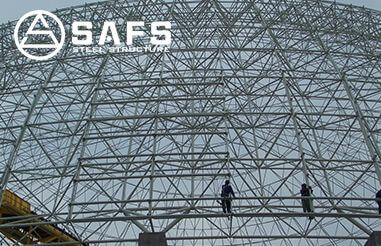Dapeng Town Industrial Park, Tongshan District, Xuzhou City, Jiangsu Province, China
(1) Uniform load distribution
Grid structure is a spatial bar structure, a grid system formed by connecting many bars. When the roof is subjected to loads, such as roof deadweight, snow load, and live load, the load can be transmitted from multiple directions through the bars and dispersed to each node and support. Avoid stress concentration and make the structure safer and more stable.
(2) Effective resistance to lateral force
When facing lateral forces such as wind load and earthquake load, the spatial stiffness of the grid plays a role to form an overall lateral force resistance system. The bars in all directions work together to constrain structural deformation, reduce lateral displacement, and ensure the safety of large-span roofs in bad weather or earthquakes.

(1) Reasonable distribution of internal force saves materials
Due to its spatial stress characteristics, the internal force distribution of grid structure bars is relatively reasonable. Under the same span and load conditions, compared with other structures, it can fully utilize the mechanical properties of materials and reduce material consumption. For example, through precise mechanical calculations, the cross-sectional dimensions of different internal force members can be reasonably configured to avoid material waste.
(2) Lightweight and high strength are conducive to large spans
Grid structures are mostly made of steel, and the high strength and light weight of steel meet the requirements of large-span roofs. The lighter weight reduces the burden on the lower structure, making it easier to achieve structural balance and stability in large spans.
(1) Rich shapes to meet design needs
Grids can achieve a variety of complex geometric shapes and curved shapes, providing architects with a broad creative space, such as circular, elliptical, saddle-shaped roofs, etc., to meet different architectural styles and functional requirements.
(2) Adapt to different building plane shapes
Whether it is a rectangular, circular or irregular building plane, the grid structure can adapt well. By adjusting the size, shape and rod arrangement of the grid, it can achieve effective coverage of the building plane.